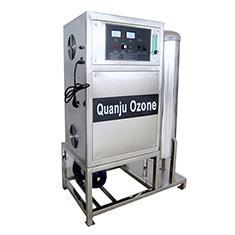High concentration ozone water machineThe principle is that the spectrum wavelength of ultraviolet light has sterilization ability in the range of 490nm-140nm. After microorganisms are irradiated by ultraviolet rays, the nuclear proteins in the gas will be denatured by absorbing the energy of the ultraviolet spectrum, causing metabolic hindrance, and then loss of reproduction ability. When the irradiation dose is increased by a certain amount, the microbial cells are damaged to death. Ultraviolet rays have a certain penetration power to clear and transparent water, so it can disinfect water.
According to the test, using a general high-concentration ozone water machine to aerate in the water, the ozone water concentration that can be achieved is 0.2-0.3mg/L. At this concentration, ozone has basically no effect on various pesticides. The test of French Buescher et al. showed that for organophosphorus pesticides that are easy to remove, the ozone concentration must reach 5-10mg/L for 10-15 minutes to achieve satisfactory removal, while for organochlorine pesticides, it can be removed under water with 20mg/L ozone. Only 15 points are 50% removed. However, soaking in ozone water with a concentration exceeding 1 to 2 mg/l will bleach fruits and vegetables and seriously destroy nutrients. Ozone oxidation alone cannot achieve the effect of removing pesticides. Using foreign cutting-edge oxidation technology, through the process of catalytic ozonation, free radicals with strong oxidation ability are formed in the water to strengthen the differentiation of the remaining pesticides, which improves the oxidation ability and reaction speed. At the same time, the ozone water concentration does not need to be high and will not damage fruits and vegetables. Nutrients.
When UV disinfection is selected, the irradiating energy required for the death of different bacteria is quite different. On the other hand, the raw water quality also has an impact on the UV sterilization effect. Due to the limited penetration of ultraviolet rays in the water, it is difficult to achieve the ideal effect. And UV disinfection cannot maintain the disinfection effect like residual chlorine.
Ozone has a stronger oxidation and disinfection ability than chlorine. It can not only sterilize and disinfect more thoroughly, but also degrade harmful components contained in water and remove heavy metal ions and various organic impurities such as iron, manganese, sulfide, benzene, and phenol. , Organic phosphorus, organic chlorine, cyanide, etc., can also deodorize and decolor water, and then achieve the purpose of water purification. Ozone has a strong ability to get used to it and is less affected by water temperature and PH value. Ozone has a wide range of habits and is not restricted by bacteria, and its sterilization effect is better than chlorine and ultraviolet sterilization. Unlike chlorine, the residual ozone can differentiate itself into oxygen without secondary pollution. The ozone-treated water is colorless, odorless, has a good taste, and can improve the quality of drinking water.


